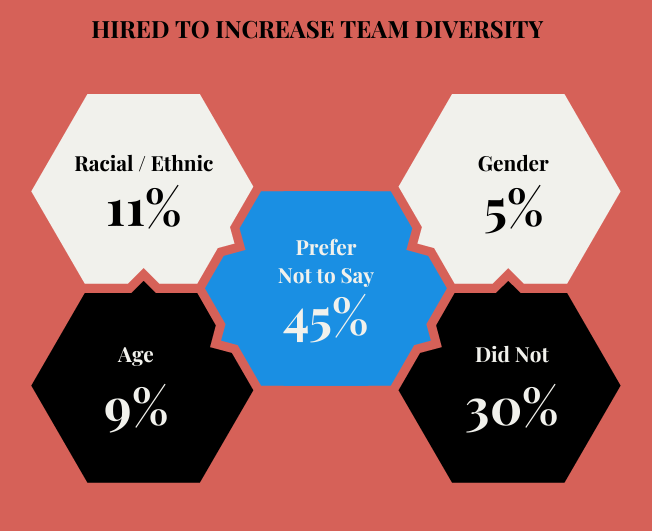Diversity is more than just an asterisk on a job posting. Statistics from our 2023 National Interior Design Business Survey show that 30% of interior design firms do not consider diversity in their hiring plans, and 45% prefer not to say so. By failing to consider or promote it, we’re missing out on the unique perspectives that come from a more diverse team.
We think that in the field of interior design, especially, it’s important that we put some of the following practices into play so our industry can continue to flourish with vision and innovation. Even more importantly, if the industry is perceived to reflect a more diverse environment, future generations of different cultures will be more likely to consider this as a field of work that they could be successful in.
Below is a little more about how a diverse workforce can benefit your office and the industry overall.

Benefits of a Diverse Workplace
Here are a few ways that your firm can make a difference in this industry-wide dilemma, starting with your hiring practices.
- Diversity fosters innovation. If your company comprises employees with similar backgrounds, they likely share similar perspectives on the nature of the work, ideas, and more. This scenario can make your workforce susceptible to groupthink. Introducing individuals from diverse backgrounds can foster the infusion of fresh ideas that can move the company forward.
- Healthy Communication. Organizations with a diverse workforce can avoid encountering challenges in communication, which will help employees build a community of trust and respect for one another.
- Lower chances of discrimination. Experiencing workplace discrimination is already a challenge, and the absence of adequate representation for a particular group in positions of authority within a company can intensify feelings of alienation and powerlessness among employees.
- All employees feel included and represented. A culture of diversity in a business can prevent an employee from feeling isolated because they will feel represented. Being in a culturally diverse setting rather than a homogeneous one can generate feelings of being understood or valued, impacting the employee’s sense of belonging and overall job satisfaction, leading to longer tenures.
“All other things being equal between two candidates, a choice can be made to recruit, hire or promote a member of a protected class over one who is not,” said one law firm. “The issue of reverse discrimination arises when there is a difference in the qualities or qualifications of the candidates, and the protected member is favored solely (or primarily) based on that person’s status as a member of a protected class.”
Steps Towards Hiring for Diversity

As you can see in the data pulled from our 2023 Interior Design Business Survey, some companies may feel uneasy about declaring the intention to hire candidates of a particular group. However, it should be understood that wanting your office to reflect the diverse population is not discriminatory. The facts are that people of color and people with disabilities are not represented in the workforce in the same numbers in which they exist in the general population. It is possible to open your pool of candidates or cast a wider net to give qualified minorities a chance to work for you. The following guide will help you to understand that there is a crucial difference between obtaining a “diversity hire” and hiring diversely. Here are some ways you can create a diverse company in a fair, non-biased way.
- Consider using an interview panel. Using an interview panel of diverse employees can help to avert potential bias in the interview process because of varying perspectives and opinions.
- Create a structured interview process. A structured and standardized interview process will make it more difficult for bias to slip through the cracks.
- Post job openings to targeted platforms. Finding job platforms targeted to particular unprotected individuals makes it easier for you as an employer to ensure that your job opportunity is reaching other audiences.
- Use neutral language in job descriptions. Avoid using coded language that may unintentionally leave others feeling excluded or unwelcome, such as “energetic” or requiring English to be a first language.
- Encourage your employees to refer their connections. If you currently have employees who are of a particular minority, it may be helpful for you to utilize them for their connection to help you grow your business to be more culturally well-rounded.
- Write company policies that appeal to diverse candidates. Consider changing your time off and scheduling policies to include more religious holidays. Also, offer more flexible work hours that will allow candidates to continue being involved with their communities and will not require them to conform to a standard 9-5 schedule.
- Integrate Merit-based skill testing. Emphasizing diversity in your hiring process does not mean that you have to overlook capabilities. Implement merit-based testing to ensure that you’re hiring the right fit.
- Use blind hiring tools. Fortunately, technology is available to help employers conduct a more blind recruiting process. These blind hiring tools can omit particular details that are less relevant to someone’s capacity for the work, such as the name of the school they attended, photos, and other extraneous details.
How to Practice Inclusivity in the Workplace
Hiring a diverse group of individuals in your company is a great step forward, but you’ll still need to ensure your practices are in line with the principles of inclusion in order for your hires to feel valued and want to stay. Inclusion is the culture in which a mix of people can come to work, feel comfortable and confident to be themselves and work in a way that suits them and delivers your business or service needs. Inclusion will ensure that everyone feels valued and, importantly, adds value. Here are some practices you can implement to make inclusivity a part of your company culture.

- Celebrate and embrace the differences of your team members. You can do things like acknowledge cultural holidays, interests, and hobbies of the people in your office.
- Stop interruptions. Take notice and take action if you feel like others are being talked over or interrupted in group settings.
- Interrupt microaggressions. Speak up if you feel like anyone might have made an insensitive comment surrounding someone’s identity.
- Establish a clear anti-discrimination policy. Have a written policy that clearly prohibits disrespectful language, discrimination, etc.
- Create a safe space for deep discussions. Make it known that team members are welcome to come to their employer with important conversations. This will create a healthy, honest work environment and help to eliminate workplace gossip.
- Involve everyone in the decision-making process. As an employer, you should make it a practice to make your team feel involved and informed about important changes that may happen in the company, no matter how big or small.
Was this helpful? If so, be sure to check out additional articles on our blog, like “Combating Ageism When Searching for a New Job.” Don’t forget to keep in touch with us on Instagram, LinkedIn, and Facebook for more industry-related content and early updates on our available career opportunities.